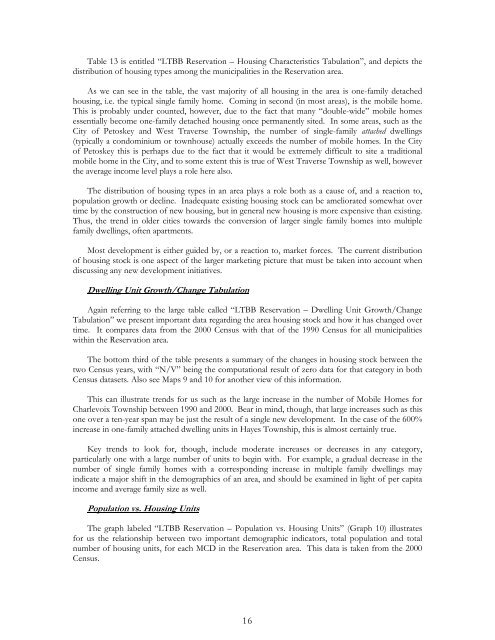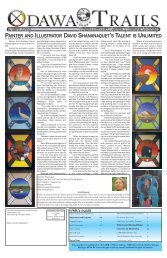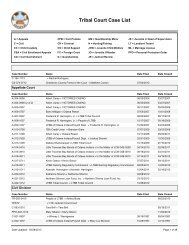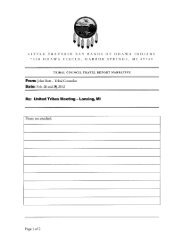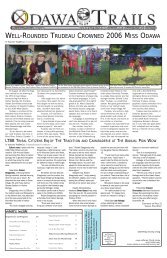LTBB Master Land Use Plan - Little Traverse Bay Bands of Odawa ...
LTBB Master Land Use Plan - Little Traverse Bay Bands of Odawa ...
LTBB Master Land Use Plan - Little Traverse Bay Bands of Odawa ...
Create successful ePaper yourself
Turn your PDF publications into a flip-book with our unique Google optimized e-Paper software.
Table 13 is entitled “<strong>LTBB</strong> Reservation – Housing Characteristics Tabulation”, and depicts the<br />
distribution <strong>of</strong> housing types among the municipalities in the Reservation area.<br />
As we can see in the table, the vast majority <strong>of</strong> all housing in the area is one-family detached<br />
housing, i.e. the typical single family home. Coming in second (in most areas), is the mobile home.<br />
This is probably under counted, however, due to the fact that many “double-wide” mobile homes<br />
essentially become one-family detached housing once permanently sited. In some areas, such as the<br />
City <strong>of</strong> Petoskey and West <strong>Traverse</strong> Township, the number <strong>of</strong> single-family attached dwellings<br />
(typically a condominium or townhouse) actually exceeds the number <strong>of</strong> mobile homes. In the City<br />
<strong>of</strong> Petoskey this is perhaps due to the fact that it would be extremely difficult to site a traditional<br />
mobile home in the City, and to some extent this is true <strong>of</strong> West <strong>Traverse</strong> Township as well, however<br />
the average income level plays a role here also.<br />
The distribution <strong>of</strong> housing types in an area plays a role both as a cause <strong>of</strong>, and a reaction to,<br />
population growth or decline. Inadequate existing housing stock can be ameliorated somewhat over<br />
time by the construction <strong>of</strong> new housing, but in general new housing is more expensive than existing.<br />
Thus, the trend in older cities towards the conversion <strong>of</strong> larger single family homes into multiple<br />
family dwellings, <strong>of</strong>ten apartments.<br />
Most development is either guided by, or a reaction to, market forces. The current distribution<br />
<strong>of</strong> housing stock is one aspect <strong>of</strong> the larger marketing picture that must be taken into account when<br />
discussing any new development initiatives.<br />
Dwelling Unit Growth/Change Tabulation<br />
Again referring to the large table called “<strong>LTBB</strong> Reservation – Dwelling Unit Growth/Change<br />
Tabulation” we present important data regarding the area housing stock and how it has changed over<br />
time. It compares data from the 2000 Census with that <strong>of</strong> the 1990 Census for all municipalities<br />
within the Reservation area.<br />
The bottom third <strong>of</strong> the table presents a summary <strong>of</strong> the changes in housing stock between the<br />
two Census years, with “N/V” being the computational result <strong>of</strong> zero data for that category in both<br />
Census datasets. Also see Maps 9 and 10 for another view <strong>of</strong> this information.<br />
This can illustrate trends for us such as the large increase in the number <strong>of</strong> Mobile Homes for<br />
Charlevoix Township between 1990 and 2000. Bear in mind, though, that large increases such as this<br />
one over a ten-year span may be just the result <strong>of</strong> a single new development. In the case <strong>of</strong> the 600%<br />
increase in one-family attached dwelling units in Hayes Township, this is almost certainly true.<br />
Key trends to look for, though, include moderate increases or decreases in any category,<br />
particularly one with a large number <strong>of</strong> units to begin with. For example, a gradual decrease in the<br />
number <strong>of</strong> single family homes with a corresponding increase in multiple family dwellings may<br />
indicate a major shift in the demographics <strong>of</strong> an area, and should be examined in light <strong>of</strong> per capita<br />
income and average family size as well.<br />
Population vs. Housing Units<br />
The graph labeled “<strong>LTBB</strong> Reservation – Population vs. Housing Units” (Graph 10) illustrates<br />
for us the relationship between two important demographic indicators, total population and total<br />
number <strong>of</strong> housing units, for each MCD in the Reservation area. This data is taken from the 2000<br />
Census.<br />
16


